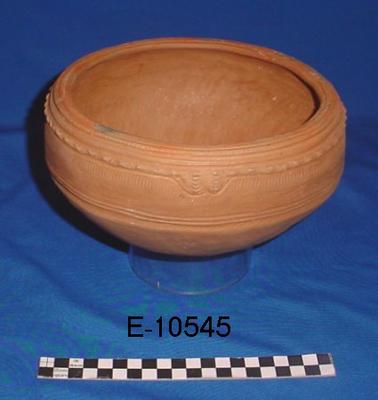Pottery
Production date
Unknown
Country
Papua New Guinea
State/Province
Milne Bay
See full details
Object detail
Description
Pottery Bowl-earthernware, applied decoration and protrusions: ALIMANU.
Classification
INDIGENOUS CULTURES Melanesian & South Sea Islander pottery
Maker
Production date
Unknown
Production place
Measurements
H.130 x Dia.222 mm
Media/Materials description
Earthenware
History and use
The basic form of the Amphlett Island pot is a round-based, cone-shaped container with an inward turning rim. Using a technique of pot-making unique in Melanesia, the vessels are built upside down. Combining slabs and rolls of clay, the pot is started with a rim and finished with a rounded bottom. Paddle beating is used to smooth and shape the body and complete the rim.
This particular type of pot (alimanu) is used as a cooking pot and usually has between three to four protrusions spaced at equal intervals around the circumference.
The majority of women from Amphlett Island, older than the age of fourteen, know how to make pottery. Although the manufacture of pottery is strictly women’s business, men traditionally carry out two roles: responsibility for gathering the clay and the distribution of the finished bowls intended for sale or exchange.
According to legend, the knowledge of pot-making originally came from Kiriwina in the Trobriand Islands. A group had left the Trobriand Islands to settle on Gumawana Island, taking clay and the art of pottery with them. One day, a dispute arose with a man called Tolalabena accusing his wife, Namaleo, of sleeping with Tolosipupu, a man from Gumawana village. Tolalabena accused Tolosipupu in front of the village and the two men came to blows. Tolalabena was defeated and left Gumawana Island with Namaleo, migrating to a place called Yayavana in Fergusson Island. However, before they left Namaleo filled her basket with clay and took it to her new home. Ever since, the clay on Gumawana has been unsuitable for making pottery and the men of the Amphletts have had to obtain their clay from Yayavana.
Uploaded to the Web 27 May 2011.
This particular type of pot (alimanu) is used as a cooking pot and usually has between three to four protrusions spaced at equal intervals around the circumference.
The majority of women from Amphlett Island, older than the age of fourteen, know how to make pottery. Although the manufacture of pottery is strictly women’s business, men traditionally carry out two roles: responsibility for gathering the clay and the distribution of the finished bowls intended for sale or exchange.
According to legend, the knowledge of pot-making originally came from Kiriwina in the Trobriand Islands. A group had left the Trobriand Islands to settle on Gumawana Island, taking clay and the art of pottery with them. One day, a dispute arose with a man called Tolalabena accusing his wife, Namaleo, of sleeping with Tolosipupu, a man from Gumawana village. Tolalabena accused Tolosipupu in front of the village and the two men came to blows. Tolalabena was defeated and left Gumawana Island with Namaleo, migrating to a place called Yayavana in Fergusson Island. However, before they left Namaleo filled her basket with clay and took it to her new home. Ever since, the clay on Gumawana has been unsuitable for making pottery and the men of the Amphletts have had to obtain their clay from Yayavana.
Uploaded to the Web 27 May 2011.
Registration number
E10545



